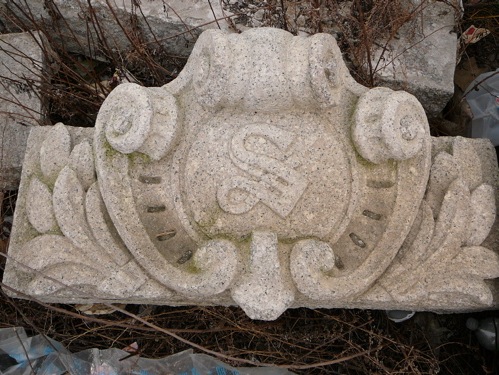113 Edward Street, Philadelphia PA 19123
(south side of Girard Avenue between 2nd Street and Hancock Street).
© Roy E. Goodman and David G.
Orr, Ph.D., Workshop of the World (Oliver Evans Press,
1990).
Christian Schmidt, an
immigrant from Wurtemberg, Germany, purchased the Robert
Courtenay brewery which primarily produced ale at this
site in 1860. The acquisition of other breweries, such as
Peter Schemm, in addition to the production of lager
beer, boosted output to 100,000 barrels by 1892. A
marked expansion of the physical plant kept pace with the
brewery's growth.
The last quarter of the nineteenth century was
Philadelphia's shining era for large and small breweries.
Bergner and Engel (120,000 barrels), and William Massey
and Company (75,000 barrels), were the third largest and
eleventh largest breweries respectively in the U. S. in
1877. By 1895, Bergner and Engel with 250,000-300,000
barrels had fallen to 15th place; the largest local
brewery. 1
Other major
companies were Engels and Wolf, Betz and Bergdoll.
Christian Schmidt was succeeded by his son Edward who
headed the company from 1895 until 1944. There were 421
employees at Schmidt's in 1943. It had survived and
thrived through new technologies—refrigeration, and
political impediments, even Prohibition, which decimated
other breweries both locally and nationally. Only
26 breweries operated in Pennsylvania in 1960.
Philadelphia lost brands such as Esslinger, Poth, Gretz
and Class and Nachod.
Schmidt family ownership ceased in 1976 with the sale of
the brewery to William H. Pflaumer. By the late 1970s
Schmidt's was the tenth-largest American brewery. It
operated a plant in Cleveland, Ohio which facilitated
mid-west regional sales. Valley Forge Brewing Company was
acquired in the 1960s, Duquesne Brewing Company
(Pittsburgh) in 1972, and label and brewing rights to
Reading and Bergheim were purchased in 1976, Rheingold in
1977, Erie Brewing Company, with its Koehler brands in
1978. 2
In 1981, Ortlieb,
the only other Philadelphia brewery, was purchased by
Pflaumer. Schmidt's, unable to cope with the marketing
muscle of the giant national brewers even though it
employed 1,400 and produced three million barrels of beer
as recently as 1984, sold its brands to G. Heileman
Brewing Company of La Crosse, Wisconsin, in April 1987.
Production of the Schmidt's labels slumped to about $1.6
million barrels in 1986, less than one percent of the
total U. S. Market. 3
The demise of
Schmidt's marked the end of the large brewery in
Philadelphia. However, one high quality, small
label, "Dock Street," claims Philadelphia as its
operational headquarters. Actually brewed in Utica, New
York by the West End Brewing Company, "Dock Street" hopes
to establish a plant in Philadelphia in the near future.
1 Downard, pp. 1701
and 2401. Schmidt's is also covered in:
Hexamer General Survey #561 (1872)
"Kensington Brewery & Malt House, Chr.
Schmidt."
Hexamer General Survey #1913 (1885)
"Kensington Beer, Ale and Porter Brewery, Christian
Schmidt."
Hexamer General Survey #2512 (1892)
"Kensington Beer Brewery, Christian
Schmidt."
Hexamer General Survey #2842 (1895)
"Kensington Beer Brewery, Christian Schmidt &
Sons."
2 Bull, et al., p.
270.
3 Terry Bivens,
"Philadelphia Beers had their Glory Days," Philadelphia
Inquirer, April 19, 1987, pgs. 1-D and
4-D.

Update May
2007 (by Torben
Jenk):
Demolished. Purchased at
auction in 2000 for $1.8 million, the developer razed the
entire site with dreams of erecting big box retail stores
and fast food restaurants among acres of parking.
Luckily, K-Mart, one of the tenants he sought, went
bankrupt. Despite objections from locals, the developer
demolished the most charming streetscape in Northern
Liberties—residential or commercial—the
cobblestone block of Edward Street between Hancock and
2nd streets which was aligned southwest toward the
skyscrapers of Center City. Monumental 19th and 20th
century brewery buildings lined either side, beautifully
built with vitrified brick. The odd configuration of this
parcel, turned 45 degrees away from the surrounding
street grid, dates back to the early 18th century tobacco
field of John Stacey. It was always fun to watch the
daylight animate this block because of its odd angle and
the reflective surfaces of the cobbles, vitrified brick,
and glass. Signature elements of the facades were
half-heartedly salvaged during demolition, the granite
columns and pilasters lie forlornly among the parking lot
of the adjacent Daniel Boone School (developed into
apartments) while the elaborately carved granite pediment
with "CS" lies face up, abandoned with a few other
granite blocks, in a vacant lot between Hancock and Front
streets.
The neighbors spent years educating and cajoling this
developer to see the real opportunities in Northern
Liberties, advocating for mixed-use residential,
small-scale retail, and live and work studio space in
renovated or new buildings, arranged in a
pedestrian-friendly way. By purchasing additional lots,
the developer now controls about 18% of the land in
Northern Liberties and he has begun to follow the
neighbors’ suggestions, seemingly with success.
However, the two hundred years of history reflected in
charming Edward Street were lost to idiotic, "scorched
earth" demolition.